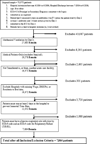Treatment with neuromuscular blocking agents and the risk of in-hospital mortality among mechanically ventilated patients with severe sepsis
- PMID: 23982029
- PMCID: PMC4760100
- DOI: 10.1097/CCM.0b013e31829eb7c9
Treatment with neuromuscular blocking agents and the risk of in-hospital mortality among mechanically ventilated patients with severe sepsis
Abstract
Objectives: Recent trials suggest that treatment with neuromuscular blocking agents may improve survival in patients requiring mechanical ventilation for acute respiratory distress syndrome. We examined the association between receipt of a neuromuscular blocking agent and in-hospital mortality among mechanically ventilated patients with severe sepsis.
Design: A pharmacoepidemiologic cohort study of patients with sepsis and a respiratory infection who had been admitted to intensive care and placed on mechanical ventilation within the first 2 days of hospitalization. We used propensity score matching and instrumental variable methods to compare the outcomes of patients treated with neuromuscular blocking agents within the first 2 hospital days to those who were not. Sensitivity analysis was used to model the effects of a hypothetical unmeasured confounder.
Setting: Three hundred thirty-nine U.S. hospitals that participated in the Premier Perspective database between 2004 and 2006.
Patients: Seven thousand eight hundred sixty-four patients met inclusion criteria, including 1,818 (23%) who were treated with a neuromuscular blocking agent by hospital day 2.
Interventions: None.
Measurements and main results: Patients who received neuromuscular blocking agents were younger (mean age, 62 vs 68), more likely to be treated with vasopressors (69% vs 65%) and had a lower in-hospital mortality rate (31.9% vs 38.3%, p < 0.001). In 3,518 patients matched on the propensity for treatment, receipt of a neuromuscular blocking agent was associated with a reduced risk of in-hospital mortality (risk ratio, 0.88; 95% CI, 0.80, 0.96). An analysis using the hospital neuromuscular blocking agent-prescribing rate as an instrumental variable found receipt of a neuromuscular blocking agent associated with a 4.3% (95% CI, -11.5%, 1.5%) reduction in in-hospital mortality.
Conclusions: Among mechanically ventilated patients with severe sepsis and respiratory infection, early treatment with a neuromuscular blocking agent is associated with lower in-hospital mortality.
Conflict of interest statement
Authors report no conflicts of interest.
Figures
Comment in
-
"Only few find the way, some don't recognize it when they do …"--can we "observe" causality?Crit Care Med. 2014 Jan;42(1):208-9. doi: 10.1097/CCM.0b013e3182a26703. Crit Care Med. 2014. PMID: 24346530 No abstract available.
References
-
- Arroliga A, Frutos-Vivar F, Hall J, Esteban A, Apezteguía C, Soto L, et al. Use of sedatives and neuromuscular blockers in a cohort of patients receiving mechanical ventilation. Chest. 2005 Aug;128(2):496–506. - PubMed
-
- Mehta S, Burry L, Fischer S, Martinez-Motta JC, Hallett D, Bowman D, et al. Canadian survey of the use of sedatives, analgesics, and neuromuscular blocking agents in critically ill patients. Crit. Care Med. 2006 Feb;34(2):374–380. - PubMed
-
- Murray MJ, Cowen J, DeBlock H, Erstad B, Gray AW, Jr, Tescher AN, et al. Clinical practice guidelines for sustained neuromuscular blockade in the adult critically ill patient. Crit. Care Med. 2002 Jan;30(1):142–156. - PubMed
-
- Latronico N, Fenzi F, Recupero D, Guarneri B, Tomelleri G, Tonin P, et al. Critical illness myopathy and neuropathy. Lancet. 1996 Jun 8;347(9015):1579–1582. - PubMed
-
- De Jonghe B, Sharshar T, Lefaucheur J-P, Authier F-J, Durand-Zaleski I, Boussarsar M, et al. Paresis acquired in the intensive care unit: a prospective multicenter study. JAMA. 2002 Dec 11;288(22):2859–2867. - PubMed
Publication types
MeSH terms
Substances
Grants and funding
LinkOut - more resources
Full Text Sources
Other Literature Sources
Medical
Miscellaneous



